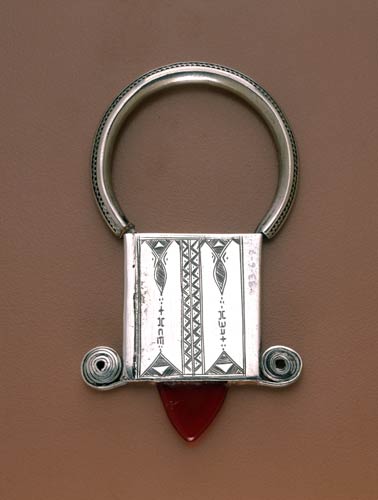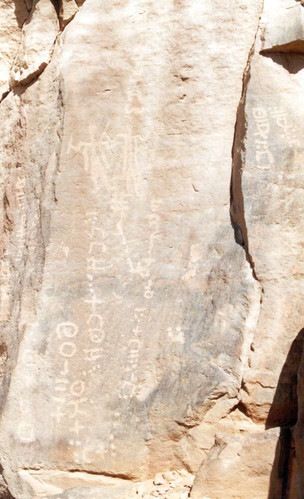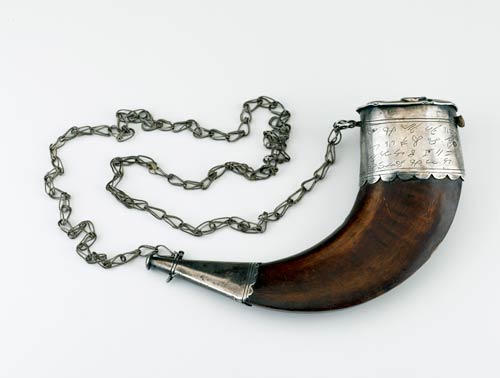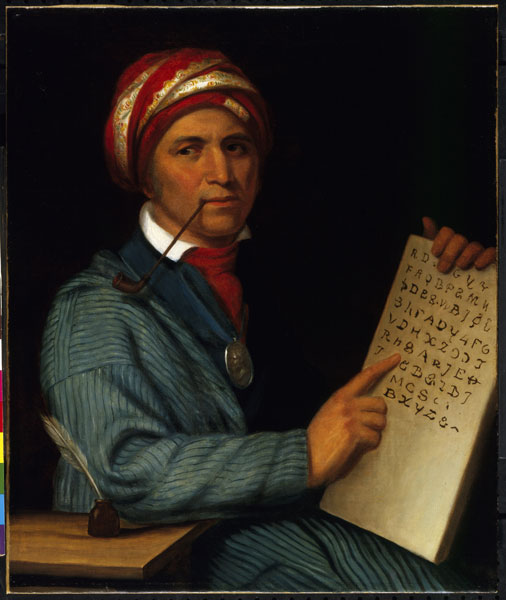|
|
Post by Tukuler al~Takruri on Apr 30, 2010 12:49:46 GMT -5
Yes, both sources agree and show Garama not Garamante is the native word.
|
|
|
|
Post by homeylu on Apr 30, 2010 16:27:49 GMT -5
I don't disagree with the extent of Garamante power since they spoke a Mande language. There is nothing in what you wrote that denies a Mande origin for this group. In Greek text the Garamante did not come from Crete they came from the Fezzan (Libya) and settled Crete. The chariot routes went from the Fezzan to Dar Tichitt. The trade went both ways so how can you claim that it was solely under Garamante control. Garamante probably ="Dry land Mande". The association of Jara and Gara is not a bad match since g and j are interchangeble in Mande languages e.g., jo and gyo 'religious cult association'. The only way we can explain Mante, is that it is an ethononym 'Mande'. . Actually it has been shown to be virtually impossible for the chariots used by the Garamante of Libya to cross the massive expansion of the Sahara desert and reach the Tichitt area. Please view the remnants of the Garamante chariot posted on the first page and explain how these 2 small wheels could have crossed the wide Sahara desert without falling apart. Widespread trade did not began in the Sahara until the camel was introduced after the turn of the century, as the horse is not suitable for long term travel in the desert. (It could not travel as far without water and food). After viewing your site, I do not see a relationship between the Mande script supposedly invented in the 17th century to the Ancient script used by the Garamante that has been in “CONTINOUS” use via the Tuareg’s Tifinagh script. Are we supposed to believe that a script disappeared and the re-emerged several centuries later in a totally different format ? Are you calling the reported ‘inventor’ of this recent script a ‘fraud’? Mande Script “ Five indigenous phonetic scripts were developed for the Mande language groups spoken in Liberia, Sierra Leone, and southwestern Mali. The oldest of these is Vai, which was invented around 1832 by Momolu Duwalu Bukele of Liberia. In the late nineteenth to early twentieth century, Vai stimulated the development of the four other scripts, all of which share similar characteristics. …….The modern form of the popular Vai script contains up to 212 characters and is written from left to right.”findarticles.com/p/articles/mi_m0438/is_3_40/ai_n19479266/pg_4/Tifinagh Script (used by Tuareg)“Traditionally, the script marks no vowels, except for word finals; however, various proposals to allow it to mark vowels have been made in recent times…The writing was usually from the bottom to the top,[/b] although right-to-left was noted. It can be found on several Tuareg tomb stones throughout the Sahara.”[/i] Savage, Andrew. 2008. Writing Tuareg — the three script options. International Journal of the Sociology of Language 192: 5-14 The Garamante script is pure abjad, no vowels are used. It is written from Bottom to top very similar to the Tuarge script. Side by side comparison of Tifinagh and Garamante Script   This is what you provided for the Mande Script (I fail to see the written similarities)  However this Vai script, does resemble the Cherokee script (who reportedly resided in Liberia around the same time the script was developed.)  www.archaeology.org/0907/trenches/cherokee.html www.archaeology.org/0907/trenches/cherokee.html |
|
|
|
Post by clydewin98 on Apr 30, 2010 23:54:48 GMT -5
Tifinagh Script (used by Tuareg)“Traditionally, the script marks no vowels, except for word finals; however, various proposals to allow it to mark vowels have been made in recent times…The writing was usually from the bottom to the top, [/b] although right-to-left was noted. It can be found on several Tuareg tomb stones throughout the Sahara.”[/i] Savage, Andrew. 2008. Writing Tuareg — the three script options. International Journal of the Sociology of Language 192: 5-14 The Garamante script is pure abjad, no vowels are used. It is written from Bottom to top very similar to the Tuarge script. Side by side comparison of Tifinagh and Garamante Script   This is what you provided for the Mande Script (I fail to see the written similarities)  However this Vai script, does resemble the Cherokee script (who reportedly resided in Liberia around the same time the script was developed.)  www.archaeology.org/0907/trenches/cherokee.html[/quote] www.archaeology.org/0907/trenches/cherokee.html[/quote]I never said that Vai is related to Tifinagh. Tifinagh is an alphabetic script used by the Berber, based on the Libyco-Berber writing. The Libyco-Berber writing is a syllabic script.The Libyco-Berber writing can be read using Vai.  You have not read much West African history. This is clear from the fact that you don’t know that people throughout the Saharan and Sahel formerly used chariots as a major means of transportation. In addition they also rode horses. As a result, your contention that chariots would have been unable to cross the Sahara is patently wrong. Also you must remember that the climatic conditions were probably different when chariots served as a major means of transportation in Africa.You can read about chariots and horseback riding in Africa here: bafsudralam.blogspot.com/search?q=chariotsclyde.winters.tripod.com/garamante.htmlEveryone notes that the Cherokee script was based on the Vai writing. As you can see from the picture above the Cherokee were greatly influenced by African Muslims note the turban |
|
|
|
Post by clydewin98 on May 1, 2010 0:03:05 GMT -5
Yes, both sources agree and show Garama not Garamante is the native word. Sources agree that Garama was name of their capital city. Garamante was the name for the tribe. Garama was the name of the capital city of the Garamantes. Pliny the Elder wrote"clarissimumque Garama caput Garamantum, the "well known Garam capital, of the Garamantes". See: www.saudiaramcoworld.com/issue/20....ert.kingdom.htm. |
|
|
|
Post by homeylu on May 1, 2010 9:16:03 GMT -5
You have not read much West African history. This is clear from the fact that you don’t know that people throughout the Saharan and Sahel formerly used chariots as a major means of transportation. In addition they also rode horses. As a result, your contention that chariots would have been unable to cross the Sahara is patently wrong. Also you must remember that the climatic conditions were probably different when chariots served as a major means of transportation in Africa.You can read about chariots and horseback riding in Africa here: bafsudralam.blogspot.com/search?q=chariotsclyde.winters.tripod.com/garamante.htmlEveryone notes that the Cherokee script was based on the Vai writing. As you can see from the picture above the Cherokee were greatly influenced by African Muslims note the turban Please don’t question my knowledge on West African history, and lets stick to the topic at hand. During the period in question, the Sahara was already in a dry phase prior to 3500 B.C. (which is why it is hypothesized that many Saharans moved to the Nile Valley). The Garamante Kingdom existed contemporaneously with AE Dynasty, as first noted by Herodotus. “ During the last 5,000 years, rainfall has been negligible, and therefore agricultural production increasingly depended on the ability to acquire water from underground sources. This was most notably achieved by the use of foggaras, subterranean tunnels which tap aquifers and lead water to cultivated plots. A minimum of 617 of these foggaras are known in the Fezzan. They provided for the basis for substantial human occupation, with population numbers possibly in the tens of thousands at their peak in the first three centuries CE (Daniels estimated 120,000 Garamantian tombs could be found along the Wadi al-Ajal). The majority of the population lived in towns and villages, though they were stereotyped as transhumant pastoralists by Greek and Roman authors. Garamantian civilization declined from c. 400 CE. The Fazzan existed outside Islamic control until the 11th or 12th century, but new trans-Saharan trade routes developed through Morocco and Algeria, and the influence of the Garamantes on the development of the desert diminished.”No one is arguing that Chariots were not driven by the Garamants in the desert. But it is illogical to assume that these small chariots could travel from the FEZZAN to the Tichitt area of Maurentania to engage in inter-Saharan trade. There existed several trade routes along the same path. There was not ONE group that traveled the entire route along, not even the Garamantes. This did not develop until the adoption of the camel. “A theory that the Garamantes, or some other Saharan people, had created chariot routes to provide Rome and Carthage with gold and ivory. However, it has been argued that no horse skeletons have been found dating from this early period in the region, and chariots would have been unlikely vehicles for trading purposes due to their small capacity.” www.absoluteastronomy.com/topics/Trans-Saharan_tradeAnd also interesting, YOU even said the horse couldn’t be used yourself on this site. www.thesahara.net/sahara_history.htm“In ancient times the horse and *donkeys* were used to pull chariots. But as the Sahara began to dry up, due to a lack of abundant water the horse was abandoned as a means of transportation in the Sahara .”I do believe the Garamante consisted of more than one tribe in existence today, but I think the Tuareg most closely resemble them as modern descendents. And if others tribes did belong during this period, they obviously abandoned the Saharan lifestyle. I cannot say if the Tuareg are actually a Mande people, since they obvious reject the Berber designation assigned to them. And personally I don’t know how language designations are derived and assigned to different people. But sometimes it appears as if you are betraying Mande as the African language from which all other languages derived, as well as Ancient America to as far away as India, and I do not understand how you arrive at such conclusions. How do languages scripts written from right to left derive from languages written from left to right, and bottom to top, etc. Please explain this to me. |
|
|
|
Post by Tukuler al~Takruri on May 2, 2010 10:53:08 GMT -5
Other occurences of Greco-Latins appending nte to African ethnies. Garam-antes ____ Garamas Alt-antes _______ Atlas The above two are a perfect match Two more examples below Atar-ante Zyg-ante Gamphaz-ante -antes appears to be a Greco-Latin suffix. Noun forming suffixes
Suffix __ Meaning ________ Origin
ant ____ thing or one who ____ Latin
ance ___ state of being ______ Latin |
|
|
|
Post by Tukuler al~Takruri on May 2, 2010 10:59:24 GMT -5
Some suppose that Tuareg, a word not used
by the Kel Tamasheq themselves, derives from
Targa the word in Tamasheq for Fezzan i.e.,
the Garamante homeland region.
The Targa were one of ethnies in the Sanhadja
confederation.
|
|
|
|
Post by Tukuler al~Takruri on May 2, 2010 19:27:29 GMT -5
Those little Garamante chariots as reconstructed and image posted above were obviously "sports cars." None of the rock art shows them laden with goods of any kind. Before camels it was supposedly done by oxcart and donkeys. A load did not stay in one 'vehicle' the whole distance. There were supposed to be stops along the way. Somewhere around ~350 BCE the Garamante "Federation" supposedly exercised control over Walata and Tichitt but not Tagant. For more see F. El-Rashdy
Garamantian Burial Customs:
their relation to those of other peoples of North Africa in
Libya AntiquaParis: Unesco (1986) pp 77-105 Robert Vernet
Préhistorie de la MauritanieNouakchott: Centre Culturel Francais A. de Saint Exupéry (1993) Mario Liverani
The Garamantes: a fresh approach Libyan Studies vol.31 Kent: Society for Libyan Studies (2000) pp 17-28 The Garamante were among the salt suppliers to the Hodh region. Actually it has been shown to be virtually impossible for the chariots used by the Garamante of Libya to cross the massive expansion of the Sahara desert and reach the Tichitt area. Please view the remnants of the Garamante chariot posted on the first page and explain how these 2 small wheels could have crossed the wide Sahara desert without falling apart. Widespread trade did not began in the Sahara until the camel was introduced after the turn of the century, as the horse is not suitable for long term travel in the desert. (It could not travel as far without water and food). |
|
|
|
Post by clydewin98 on May 2, 2010 22:12:59 GMT -5
Other occurences of Greco-Latins appending nte to African ethnies. Garam-antes ____ Garamas Alt-antes _______ Atlas The above two are a perfect match Two more examples below Atar-ante Zyg-ante Gamphaz-ante -antes appears to be a Greco-Latin suffix. Noun forming suffixes
Suffix __ Meaning ________ Origin
ant ____ thing or one who ____ Latin
ance ___ state of being ______ Latin I could not find these suffixes with the meanings you give in any Latin distionaries: Unversity of Notre Dame on=line Grammar and dictionary -ante= ‘before, in front. forward Lewis and Short On-line Dictionary v *ant 1 3p pr act ind they see, they do see, they are seeing v *ant 2-5 3p pr act sub they might see, should they see. ent (-ient), -ant (iant) equivalent to the English present participial ending -ing (-ens, -ans) p.209 See: students.washington.edu/nwk/clas205/suffixes.htmlI could not find the ending antes It appears that many Latin names for countries ended in -nia. Albion Great Britain Britannia Great Britain Caledonia Scotland Germania Germany Hibernia Ireland The term Mande equals "mother's child", indicating that these Mande speakers belonged to matriarchial societies, as opposed to Bambara "fathers child". Use of the term Mante/Mande probably indicated that these tribes living in the Fezzan belonged to matriarchial societies. This indicates that these people in the Fezzan were called Garamantes--not Garama. . |
|
|
|
Post by Tukuler al~Takruri on May 3, 2010 11:36:23 GMT -5
The ante you gave is a prefix not a suffix.
One form of my supplied suffixes ant and
ance is right there on the very webpage
you say doesn't have it. Check Lesson 31
number 3.
If you enter all the words from each column
in the row of either of the two suffixes I gave
you into a search engine you too will find them.
What other suffixes used in country names has
nothing to do with the African ethnic names
- Garamantes from Garamas
- Atlantes from Atlas
- Atarantes
- Gyzantes
- Gamphazantes.
Garamante is the people, Garamantia the nation.
Again all this is from a non-African language base.
The African language(s) this is based on has the
word Garama/Djerma/Jerma (soft g like a j not a
hard g like in gate).
According to Reynolds-Marniche Garama/Djerma
means place of the Gara in Teda-Kanuri dialects.
She is also of the opinion that the Garamantes
are so named by the Greco-Latins after their
later capital city Garama/Djerma.
|
|
|
|
Post by clydewin98 on May 3, 2010 13:40:04 GMT -5
The ante you gave is a prefix not a suffix. One form of my supplied suffixes ant and ance is right there on the very webpage you say doesn't have it. Check Lesson 31 number 3. If you enter all the words from each column in the row of either of the two suffixes I gave you into a search engine you too will find them. What other suffixes used in country names has nothing to do with the African ethnic names - Garamantes from Garamas - Atlantes from Atlas - Atarantes - Gyzantes - Gamphazantes. Garamante is the people, Garamantia the nation. Again all this is from a non-African language base. The African language(s) this is based on has the word Garama/Djerma/Jerma (soft g like a j not a hard g like in gate). According to Reynolds-Marniche Garama/Djerma means place of the Gara in Teda-Kanuri dialects. She is also of the opinion that the Garamantes are so named by the Greco-Latins after their later capital city Garama/Djerma. This is the opinion of a modern researcher. The ancients had a different take on the situation as noted by Pliny. This opinion does not agree with Pliny. Garama was the name of the capital city of the Garamantes. Pliny the Elder wrote"clarissimumque Garama caput Garamantum, the "well known Garam capital, of the Garamantes". See: www.saudiaramcoworld.com/issue/20....ert.kingdom.htm. |
|
|
|
Post by Tukuler al~Takruri on May 3, 2010 15:54:22 GMT -5
Need I remind you that you and I are modern researchers and what we both are doing are giving our opinions and the sources we base them on. I think all concur that Garama/Djerma was the name of the capital. That's all Pliny is saying. Your quote doesn't show Pliny saying anything about where the name comes from. De Zurara basing himself on Isidore (posted hereearlier says The Garamantes are so called from
Garama, which is the capital of their kingdom. In turn we have it that Garama was named after Garamas the eponymous ancestor of the people. Since neither Garamas nor Garama have an ntein them we conclude nte is a suffix not found on the name of Garamas the eponymous ancestor nor on Garama the city named after Garamas. Thus the nte suffix holds well when appended to Garama making Garama-nte mean those of
Garama(s) just as the Atla-nte are those of
Atlas. Again, this is a name Greco-Latin writers bestowed on them. We have no record of the name they used themselves unless it be either Garamas or Garama, native words, neither of which have mante in them. There is no ancient source for mante. And just as you said regarding Reynolds-Marniche's statement, the same holds true for mante, it's a modern researcher's opinion. |
|
|
|
Post by clydewin98 on May 3, 2010 22:44:01 GMT -5
Need I remind you that you and I are modern researchers and what we both are doing are giving our opinions and the sources we base them on. I think all concur that Garama/Djerma was the name of the capital. That's all Pliny is saying. Your quote doesn't show Pliny saying anything about where the name comes from. De Zurara basing himself on Isidore (posted hereearlier says The Garamantes are so called from
Garama, which is the capital of their kingdom. In turn we have it that Garama was named after Garamas the eponymous ancestor of the people. Since neither Garamas nor Garama have an ntein them we conclude nte is a suffix not found on the name of Garamas the eponymous ancestor nor on Garama the city named after Garamas. Thus the nte suffix holds well when appended to Garama making Garama-nte mean those of
Garama(s) just as the Atla-nte are those of
Atlas. Again, this is a name Greco-Latin writers bestowed on them. We have no record of the name they used themselves unless it be either Garamas or Garama, native words, neither of which have mante in them. There is no ancient source for mante. And just as you said regarding Reynolds-Marniche's statement, the same holds true for mante, it's a modern researcher's opinion. It is clear we disagree. I believe the tribal name was Garamante, basd on the linguistic evidence. A major group from Libya that settled Crete were the Garamante. Robert Graves in (Vol.1, pp.33-35) maintains that the Garamante who originally lived in the Fezzan fused with the inhabitants of the Upper Niger region of West Africa. The name Garamante, illustrates affinity to Mande morphology and grammar. The Mande language is a member of the Niger-Congo group of languages. The name for the Manding tribe called "Mande", means Ma 'mother, and nde 'children', can be interpreted as "Children of Ma", or "Mothers children " (descent among this group is matrilineal) . The word Garamante,can be broken down into Malinke-Bambara into the following monosyllabic words Ga 'hearth', arid, hot'; Mante/Mande , the name of the Mande speaking tribes. This means that the term: Garamante, can be interpreted as "Mande of the Arid lands" or "Arid lands of the children of Ma". This last term is quite interesting because by the time the Greeks and Romans learned about the Garamante, the Fezzan was becoming increasingly arid. Keftiu The Egyptians called the Cretans Keftiu. There is agreement between the Keftiu names recorded by Egyptian scribes (T.E. Peet, "The Egyptian writing board BM5647 bearing Keftiu names". In , (ed.) by S Casson (Oxford, 1927, 90-99)), and Manding names. Keftiu The root kef-, in Keftiu, probably is Ke'be, the name of a Manding clan , plus the locative suffix {i-} used to give the affirmative sense, plus the plural suffix for names {u-}, and the {-te} suffixial element used to denote place names, nationalities and to form words. On the Egyptian writing board there are eight Keftiu names. These names agree with Manding names: Keftiu....... Manding sh h.r........ Sye Nsy ..........Nsye 'ksh .........Nkyi Pnrt Pe,..... Beni (name for twins) 'dm ..........Demba Rs............. Rsa This analogy between Keftiu and Manding names is startling. In conclusion, the evidence of similarity between Keftiu names and names from the Manding languages appear to support Graves view that the Eteocretans, who early settled Crete may have spoken a language similar to the Mande people who live near the Niger. It also supports the idea that Garamante was a tribal name resulting from the Mande origin of this population--not that they were named after their city. You believe it is Garama. Given this fact we can end the argument now since we will continue to disagree. . |
|
|
|
Post by Tukuler al~Takruri on May 4, 2010 10:18:40 GMT -5
All reasonable points should be developed and looked into though no one should be forcibly swayed to adopt any conclusion they feel is less tenable. Rather than argue I bring supporting evidence and reasoning for Garamante <-- Garama <-- Garamas which tends to negate that mante is any integral factor of Garamante since both Garamas and Garama, the native words, have ma but lack mante backing the idea that nte was tacked onto Garama by the Greco-Latins. Gabriel Camps finds the meaning of Garamantes in the 'Berber' languages.
Le nom même des Garamantes signifierait « les gens des maisons ». La racine arhrham ,
« maison, construction », est une racine pan-berbère. Les nombreuses ruines de l'oued
El-Agial témoignent en faveur de cette hypothèse.
In his view the root arhrham, which is in all 'Berber' dialects is the etymology for Garama. The root is supposed to mean house(s) or building(s). |
|
|
|
Post by Tukuler al~Takruri on May 4, 2010 10:21:04 GMT -5
One cannot dismiss that Garma provides the naming for Garamantes
when Isidore of late antiquity contemporaneous to last days of their
federation intimates so. One may not like it but it is one possibility to
consider.
Since our notices of the ancient Garamante comes from Greco-Latin
we are reliant on them for what grains of information the Garamante
have on record about themselves. There are documents written in
the Libyan or Tifinagh script that were authored by the Garamante.
So far they are not easily accessable or translated, afaik.
Let's look at what the myths say again.
|
|